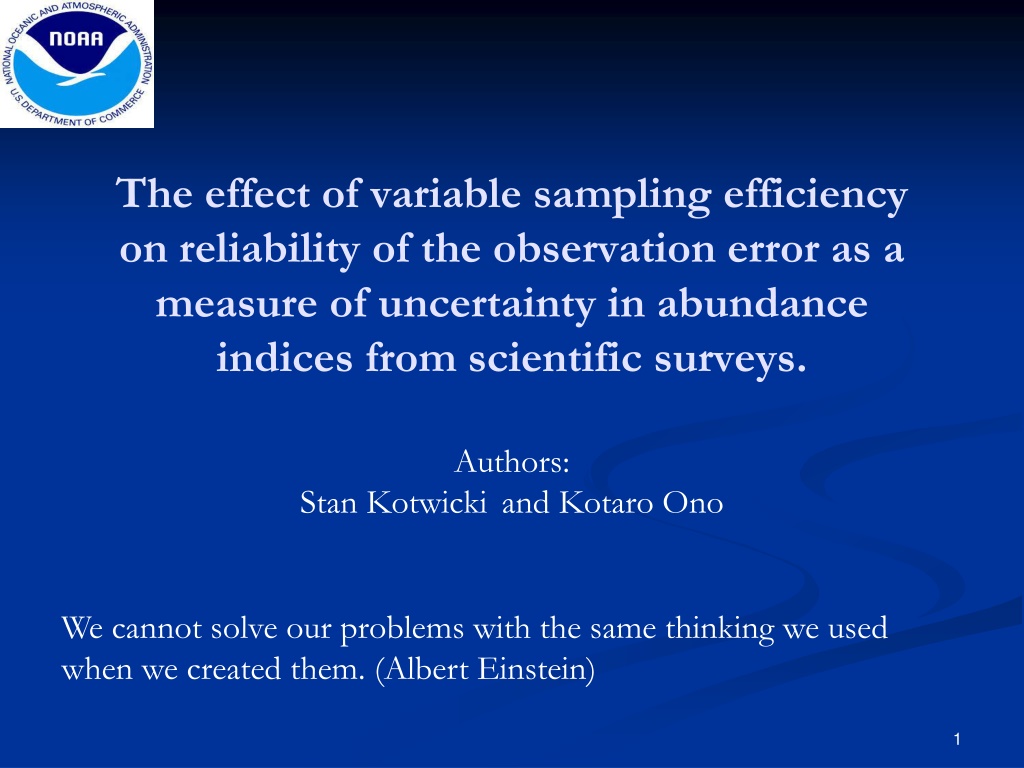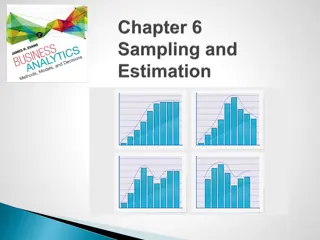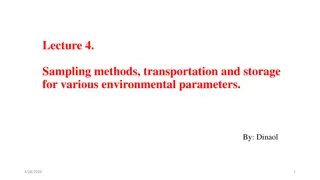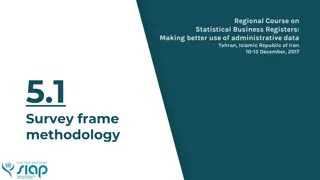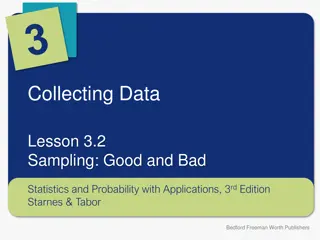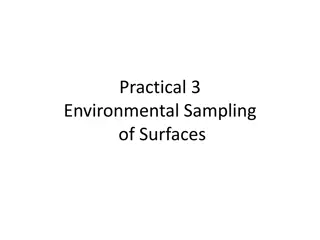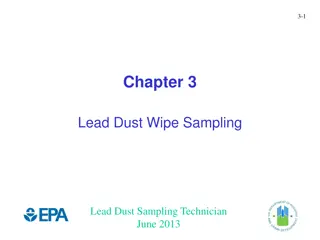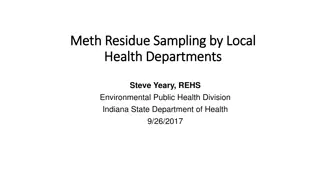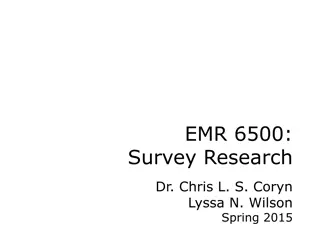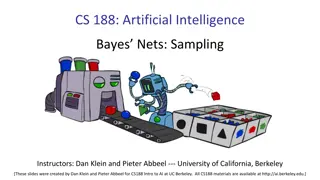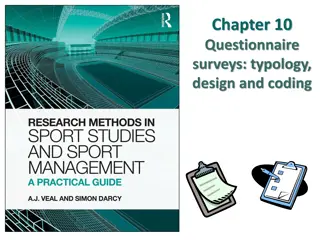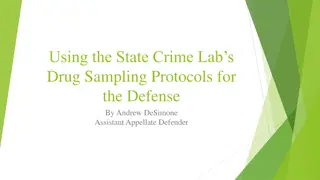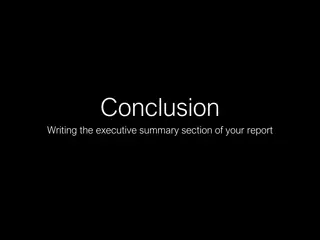Understanding Variable Sampling Efficiency in Scientific Surveys
Exploring the impact of variable sampling efficiency (qe) on the reliability of observation error in abundance indices from scientific surveys. Authors delve into the complexities of survey design, factors affecting qe, and the need to adapt to variable efficiency. Studies show both random and non-random components influencing qe, with implications for abundance estimates and age composition data.
Download Presentation

Please find below an Image/Link to download the presentation.
The content on the website is provided AS IS for your information and personal use only. It may not be sold, licensed, or shared on other websites without obtaining consent from the author. Download presentation by click this link. If you encounter any issues during the download, it is possible that the publisher has removed the file from their server.
E N D
Presentation Transcript
The effect of variable sampling efficiency on reliability of the observation error as a measure of uncertainty in abundance indices from scientific surveys. Authors: Stan Kotwicki and Kotaro Ono We cannot solve our problems with the same thinking we used when we created them. (Albert Einstein) 1
Survey sampling efficiency Sampling efficiency (qe) = survey selectivity * catchability Variable in time and space. Impossible to design surveys with constant qe,, because multiple factors are affecting it (e.g. variation in the geometry of the trawl, variation in fish behavior in response to the gear, variation in fish behavior in response to the environment, patchiness) We may have to accept variable qe and learn how to deal with it Variability in qe could be just random (unlikely) or have random and non-random components (i.e. depend on multiple variables; likely). To date all studies of qe show random component Increased number of studies show qe dependence on some variables None of the studies show constant qe 2
Examples Pollock Snow crab Kotwicki, S, Horne, J. K., Punt, A. E., and Ianelli, J.N. 2015. Factors affecting the availability of walleye pollock to acoustic and bottom trawl survey gear. ICES J. Mar. Sci. Somerton, D.A., Weinberg, K.L. and Goodman, S.E. 2013 Catchability of snow crab (Chionoecetes opilio) by the eastern Bering Sea bottom trawl survey estimated using a catchcomparison experiment 3
Spatial distribution of qe What exactly u and mean in this context? What is effect on age composition data? The formula to estimate variance for index of abundance from this survey does not exist. Kotwicki, S, Ressler, P.H., Ianelli J. N., Punt, A. E., and Horne, J. K. In review. Combining data from bottom trawl and acoustic surveys to improve reliability of the abundance estimates. CJFAS. 4
Relative weights can change Kotwicki, S., Ianelli, J. N., and Punt, A. E. 2014. Correcting density-dependent effects in abundance estimates from bottom trawl surveys. ICES J. Mar. Sci. 71:1107-1116. 5
Simulating species distribution Based on Pollock Fit spatio-temporal model to survey data (Thorson et al. 2015, Ono et al. 2015) Create map of predicted species distribution (MCMC) 6
Simulating surveys Assumed SRS design 376 samples over the survey area (ui) qe gamma distributted Statistics: 2 ( ) u u u 2 N Survey mean and variance i s i = = i u i , and s s N True mean and variance 8
Simulating surveys Years 2005 2014 Sampling efficiency (qe) 0.01, 0.05, 0.1, 0.2, 0.4, 0.6, 0.8, 1, 1.5, 2, 2.5, 3 0.00001, 0.01, 0.1, 0.2, 0.4, 0.6, 0.8, 1, 2 1 (strong), 100, 500, 2000, 50000 (weak) Variance in qe Density dependent qe (assuming qe = 1 at low densities) 9
Deviation of survey mean from true mean Biased mean for low qe surveys, For surveys with high qe survey mean is unbiased Increase in variance of the mean when qe low 10
Survey CV High variation in qe - higher observation error. Not much concern for surveys with high qe. Concern: High variation in qe - increased variance in survey CV estimate. 11
Deviation of survey SD from true SD Low qe - SD biased low. Increase in V(qe ) increase V(SD) High qe - SD unbiased . 12
CV of survey SD Constant efficiency does not assure good precision of the SD estimate. Increase in V(qe ) increase V(SD) 13
Are these just spurious? 0.3 0.25 0.2 CV 0.15 0.1 0.05 0 0 50 100 150 200 Mean CPUE 14
Density dependent qe Strong density dependence survey CV biased low. Strong effects! Density dependent qe - hyperstable index, but appears highly precise. 15
More on density dependent qe Not much has been done. 4 studies 5 species (all semipelagic), all show density dependent (hyperstable) qe for bottom trawl. Environmental effects on qe most likely result in some form of density dependent qe because environment affects both qe and fish distribution. So environmentally induced variation in qe will likely result in decrease in both accuracy and precision of survey variance estimates. 16
Sampling processes are not represented in the main structure of the stock assessment models (Maunder and Piner 2014) but they may be a major contributor to the total uncertainty of the mean, variance and age composition derived from scientific surveys. 2 ( ) u u i s 2 = i s N State of the art survey design based variance estimators (SRS, Stratified, Cluster, geostatistical, etc) do not account for the variance in qe., hence they maybe biased and imprecise. It maybe advisable to redirect efforts from the design based variance estimates to estimates of total survey variance. Reliability of survey derived abundance estimates should not be assessed using CV estimated from observation error alone We still need to look into effect of variation in availability due to limited survey coverage. 17
What to do? Account for the uncertainty in the observation error (weights) estimates in the stock assessments? Estimate qe , and V(qe) Incorporate sampling process into stock assessments? Don t diss the survey, but understand the implications of variable qe on the statistics derived from survey data. 18
Questions for discussion Knowing that SD estimates may be biased and uncertain is it still a good practice to weight indices of abundance using SD? How to deal with uncertainty in the SD estimates, when this uncertainty can be estimated? Is the adjusting variance for indices estimates a good practice? Does it inflate the variance of the index of abundance? 19
Thanks 20
How to evaluate surveys? Observation error may not reflect completely total uncertainty of the index of abundance. Therefore using observation error (sampling variance) to weight indices may lead to biases in stock assessments. Examples of possible sources of additional uncertainty in survey index: Catchability variable in time and space due to environmental effects Density dependent sampling efficiency Survey does not encompass entire population Correlation in age and length data 21
Maunder and Piner 2014 Temporal trends in catchability (e.g. Harley et al. 2001) in addition to uncertainty in mean catchability are particularly problematic, since they will bias estimates of depletion levels. Therefore, uncertainty in both the average level of catchability and the variation over time can contribute substantially to the uncertainty in stock assessment results and estimates of management quantities. Process error is additional variability in the population (e.g. recruitment), fishing (e.g. selectivity), or sampling processes (e.g. survey catchability) that are not represented by the main structure of the model. One example is the inflation of standard deviations for survey data because of temporal variability in catchability due to factors such as the environmental conditions. Another is the reduction in the effective sample size of composition data due to unmodelled correlation in the sampling process (i.e. many species school by size and repeated samples from a purse-seine set on a single school will be correlated). 22
Effect on age composition Kotwicki, S., Ianelli, J. N., and Punt, A. E. 2014. Correcting density-dependent effects in abundance estimates from bottom trawl surveys. ICES J. Mar. Sci. 71:1107-1116. 23
Main findings Catchability of BT and acoustic surveys is variable in time and space. Survey standardization not enough Abundance estimates can be corrected for variable catchability but only if Only combined estimates provided reliable abundance estimate corrected for variable catchability Methodology can be used for studies of vertical distribution of semipelagic species 24
Survey variance simply explained. What is it? Why is it important? Where it comes from? How to estimate it? 25
Mark Maunder guidance. Don t naively down-weight the data - Don t naively weight the data using incorrect estimate of variance Data recommendations: design surveys to have constant asymptotic selectivity, estimate q. - Estimating q is hard but usually possible. - Designing surveys to have constant asymptotic selectivity may be impossible - Design surveys to minimize variation in sampling efficiency 26
V(qe) Is there an elephant in the room? 29
